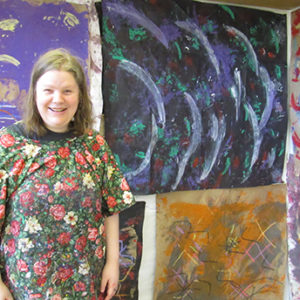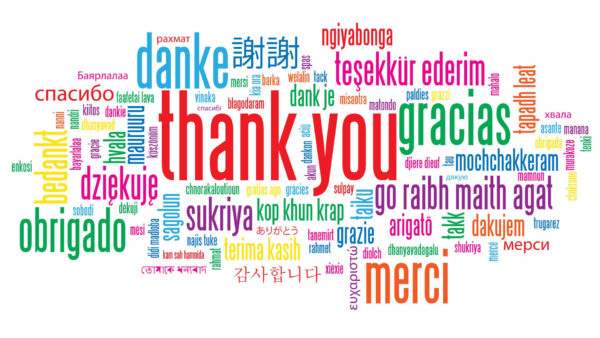Blind Since Birth, Client Revels in Creating Art
 Rachel Homme made her way to the back corner of the Solstice Art and Wellness Studio. She and a volunteer chatted as Rachel donned her smock and adjusted the ties. The volunteer rolled up a cart filled with gallon-sized plastic bottles of paint.
Rachel Homme made her way to the back corner of the Solstice Art and Wellness Studio. She and a volunteer chatted as Rachel donned her smock and adjusted the ties. The volunteer rolled up a cart filled with gallon-sized plastic bottles of paint.
The volunteer tore off a few feet of the rolled paper and set it on the table, then pumped out dollops of paint in a specific order for the artist before moving to help other participants in the studio.
Twice a week, Rachel attends the studio and sits in what has become her corner, surrounded by her creations that cover a small stretch of two walls, stacked floor to ceiling.
Blind since birth, Rachel has never seen any of the work she has created.
“I think I can see some colors, but not like you would. It’s all fuzzy,” she said.
Her mom, Christine Homme, said Rachel has created a colorful life for herself.
“Her art has always been interesting,” Christine said. “She’s literally drawing outside the box, because she can’t see the box!”
A Rare Diagnosis
Rachel was about 7 years old when diagnosed with Laurence-Moon-Bardet-Biedl Syndrome, a rare genetic condition that affects about 1 in 100,000 children. Named after the doctors who initially described the symptoms, the more common effects are blindness and a higher propensity toward mental illness.
Now 40 years old, Rachel has come to possess a notable resilience and persistence—not to mention a wicked sense of humor—that marks a creative, independent individual, her mom said.
“Rachel is a tenacious individual. She’s analytical and patient,” Christine said. “She’s able to work through a lot of problems. She’s always been highly creative.”
Rachel loves art, heavy metal music and movies. She lives in an adult family home and attends Full Life Care’s adult day health program, as well as the Solstice Art and Wellness Studio. She previously worked at the Lighthouse for the Blind as a machine operator and recently started volunteering at the Washington Talking Book and Braille Library.
“I’ve gone through a lot, but I’ve learned to accept it,” she said. “There’s still a lot of things I want to do.”
She hesitated for a moment. “My life is complicated.”
Christine agreed that Rachel’s life isn’t easy, but said she has seen a notable improvement in Rachel of late.
“I am so grateful for Full Life Care,” Christine said. “It is a good avenue for getting her outside the house. Her sense of satisfaction in life has improved. She has a purpose and something to look forward to.”
The artist
At the art studio, Rachel dips her fingers into the paint then she slowly and methodically pours the emotions of the moment from her mind onto the paper.
When you look at her art, “you can see what’s been going on in her head,” Christine said.
Rachel can mentally visualize colors and has learned to connect them with emotions. The colors she uses are dictated by her mood.
Red paint is for the times when she’s angry, uncertain or anxious.
Blue is mostly happy, but also represents sadness or feeling empty.
“There are so many thoughts to one color,” she said. “My friends taught me about colors.”
Rachel learned to paint in high school and she took some art classes in college. She tried spinning pottery, but that didn’t go so well. Hand-forming clay art works better. But painting is her favorite activity. Her mom buys paint that has braille labels.
“If I’m excited or angry, it’s more like splatter paint or more like … it comes out faster, I guess,” she said. “If I’m happy or have more-controlled emotions, it’s calmer. Or if I’m sad, it’s more controlled.”
At the end of the day, Rachel and a volunteer clean up the workspace. Sometimes the day’s creations are added to her wall at Solstice. Some go home and are added to the walls in her room there. Other work is donated or given away.
After she cleans up, she joins a few other participants to wait for her bus home.
“If I wasn’t here, I probably wouldn’t be doing a whole lot,” Rachel said. “I’ve changed a lot since coming to Full Life Care; in good ways. It’s made me feel better about myself.”

